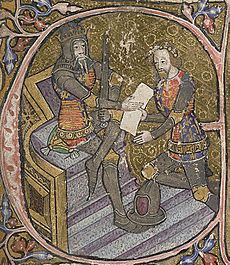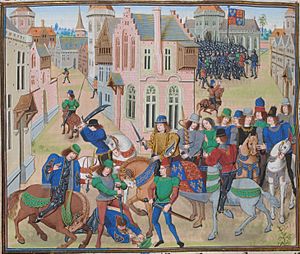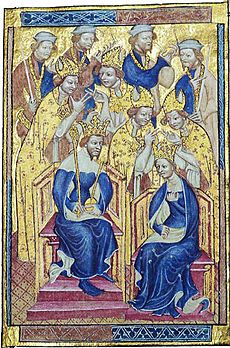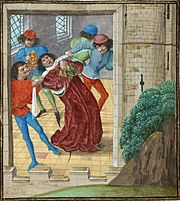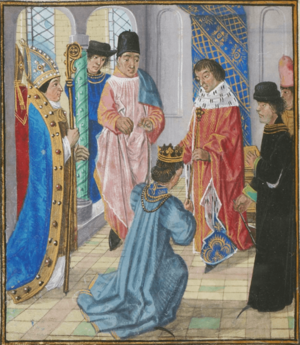Richard II of England facts for kids
Quick facts for kids Richard II |
|
|---|---|
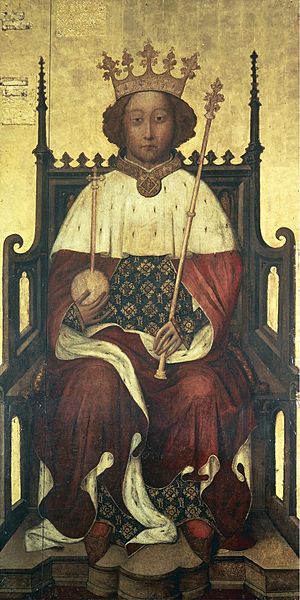
Portrait at Westminster Abbey, mid-1390s
|
|
| King of England (more...) | |
| Reign | 22 June 1377 – 29 September 1399 |
| Coronation | 16 July 1377 |
| Predecessor | Edward III |
| Successor | Henry IV |
| Born | 6 January 1367 Bordeaux, France |
| Died | c. 14 February 1400 (aged 33) Pontefract Castle, Yorkshire, England |
| Burial | 6 March 1400 Kings Langley, Hertfordshire 1413 Westminster Abbey, London |
| Spouse |
|
| House | Plantagenet |
| Father | Edward the Black Prince |
| Mother | Joan, 4th Countess of Kent |
| Signature |  |
Richard II (born 1367, died 1400), also called Richard of Bordeaux, was the King of England from 1377 until he was removed from power in 1399. He was the son of Edward the Black Prince and Joan, Countess of Kent. Richard's father died in 1376, making young Richard the next in line to the throne after his grandfather, King Edward III. When Edward III died, 10-year-old Richard became king.
During Richard's first years as king, England was ruled by special councils. These councils were influenced by Richard's uncles, John of Gaunt and Thomas of Woodstock. England faced many challenges, especially the Hundred Years' War against France. A big problem during his rule was the Peasants' Revolt in 1381. The young king played a key role in stopping this uprising. Richard was less interested in war than his father or grandfather. He wanted to end the Hundred Years' War.
Richard strongly believed in the king's power. He tried to limit the power of the rich noble families. Instead, he relied on his own group of loyal followers for protection. Unlike his grandfather, Richard created a fancy court focused on art and culture. Here, the king was seen as a very important and special person.
Richard's reliance on a few close friends made powerful nobles unhappy. In 1387, a group of aristocrats called the Lords Appellant took control of the government. By 1389, Richard had regained power. For the next eight years, he ruled fairly well with his former opponents. But in 1397, he got his revenge on the Appellants. Many of them were executed or sent away. Historians call the next two years Richard's "tyranny" because he ruled very harshly.
In 1399, after John of Gaunt died, Richard took away the inheritance of Gaunt's son, Henry Bolingbroke. Henry had already been sent out of the country. Henry invaded England in June 1399 with a small army that quickly grew. He faced little resistance. Henry removed Richard from the throne and became king himself. Richard is believed to have died from starvation while imprisoned. However, some questions remain about how he died.
Richard's reputation after his death was greatly shaped by William Shakespeare's play Richard II. The play showed Richard as a bad ruler whose actions led to the Wars of the Roses in the 15th century. Modern historians don't agree with this idea. They do, however, believe Richard was responsible for losing his throne. While probably not insane, he may have had a difficult personality, especially towards the end of his rule. Most experts agree that his plans were not unrealistic. But the way he carried them out was unacceptable to the powerful people of his time, which led to his downfall.
Contents
Richard's Early Life: Becoming King
Richard of Bordeaux was the younger son of Edward the Black Prince and Joan, Countess of Kent. Edward, the oldest son of King Edward III, was the heir to the English throne. He was a famous military leader in the early parts of the Hundred Years' War. He was especially known for his victory at the Battle of Poitiers in 1356. But after more military adventures, he got sick in Spain in 1370. He never fully recovered and had to return to England the next year.
Richard was born in the Archbishop's Palace of Bordeaux in Aquitaine, France, on January 6, 1367. This was the feast of Epiphany. Later, this was used in the famous Wilton Diptych painting. In the painting, Richard is shown as one of three kings honoring the Virgin Mary and Child.
Richard's older brother, Edward of Angoulême, died around his sixth birthday in 1370. The Black Prince, Richard's father, finally died from his long illness in June 1376. People in the English Parliament were worried that Richard's uncle, John of Gaunt, would try to take the throne. Because of this, Richard was quickly given the title of Prince of Wales and his father's other titles.

On June 21, 1377, Richard's grandfather, King Edward III, died after ruling for 50 years. Edward III had been weak and old for some time. This meant that 10-year-old Richard became king. He was crowned on July 16 at Westminster Abbey. Again, fears about John of Gaunt's ambitions influenced decisions. A regency (a period when the king is too young to rule, so others rule for him) led by the king's uncles was avoided. Instead, the king was supposed to rule with the help of "continual councils." John of Gaunt was not part of these councils.
Gaunt, along with his younger brother Thomas of Woodstock, still had a lot of informal power over the government. But the king's advisors and friends, especially Sir Simon de Burley and Robert de Vere, 9th Earl of Oxford, slowly gained more control over royal matters.
Within three years, these advisors lost the trust of the Parliament. So, the councils were stopped in 1380. People were also unhappy because of very high taxes. Three poll taxes were collected between 1377 and 1381. This money was spent on failed military trips to Europe. By 1381, there was a strong feeling of anger against the ruling classes among the common people of England.
Early Challenges: The Peasants' Revolt
The Uprising of 1381
The poll tax of 1381 was the immediate cause of the Peasants' Revolt. But the real reasons for the conflict were tensions between peasants and landowners. These tensions grew because of the economic effects of the Black Death and later outbreaks of the plague. The rebellion started in Kent and Essex in late May. On June 12, groups of peasants gathered at Blackheath near London. Their leaders were Wat Tyler, John Ball, and Jack Straw.
John of Gaunt's Savoy Palace was burned down. The Archbishop of Canterbury, Simon Sudbury, and the Lord High Treasurer, Robert Hales, were both killed by the rebels. The rebels demanded an end to serfdom, a system where peasants were tied to the land. The king, safe inside the Tower of London with his advisors, agreed that the Crown did not have enough soldiers to stop the rebels. The only choice was to talk to them.
It's not clear how much Richard, who was only fourteen, was involved in these talks. But historians think he was among those who wanted to negotiate. The king went by the River Thames on June 13. However, so many people were on the banks at Greenwich that he couldn't land. He had to return to the Tower. The next day, June 14, he rode out on horseback and met the rebels at Mile End. He agreed to their demands. But this only made the rebels bolder; they continued to loot and kill.
Richard met Wat Tyler again the next day at Smithfield. He repeated that their demands would be met. But the rebel leader didn't believe the king was sincere. The king's men became restless. A fight broke out, and William Walworth, the Lord Mayor of London, pulled Tyler off his horse and killed him. The situation became tense when the rebels realized what had happened. But the king acted calmly and bravely. He said, "I am your captain, follow me!" and led the crowd away from the scene. Walworth gathered a force to surround the peasant army. But the king offered forgiveness and allowed the rebels to go home.
The king soon took back the promises of freedom and pardon he had given. As unrest continued in other parts of the country, he personally went to Essex to stop the rebellion. On June 28 at Billericay, he defeated the last rebels in a small fight. This effectively ended the Peasants' Revolt. Despite his young age, Richard had shown great courage and determination. However, these events likely made him realize the dangers of disobedience. This helped shape his belief in absolute royal power, which would later cause problems for his rule.
Richard Grows Up: Marriage and New Friends
After the Peasants' Revolt, Richard's actions become clearer in historical records. One of his first important acts after the rebellion was marrying Anne of Bohemia on January 20, 1382. Anne was the daughter of Charles IV, Holy Roman Emperor. This marriage was important for diplomacy. During the Western Schism, when Europe was divided, Bohemia and the Holy Roman Empire were seen as possible allies against France in the ongoing Hundred Years' War. However, the marriage was not popular in England. Despite large sums of money given to the Empire, the alliance never led to military victories. Also, the marriage had no children. Anne died from the plague in 1394, and Richard was very sad.
Michael de la Pole played a key role in the marriage talks. He had the king's trust and became more involved in the court and government as Richard grew up. De la Pole came from a merchant family, not a noble one. When Richard made him chancellor in 1383 and then Earl of Suffolk two years later, it angered the older, more established noble families. Another person close to the king was Robert de Vere, Earl of Oxford. He became the king's favorite. Richard's close friendship with de Vere also upset the powerful nobles. This anger grew when de Vere was given the new title of Duke of Ireland in 1386.
Tensions grew over how to handle the war with France. The king's close circle preferred to negotiate for peace. But Gaunt and Buckingham wanted a large military campaign to protect English lands. Instead, a so-called crusade led by Henry le Despenser, Bishop of Norwich, was sent. It failed badly. Facing this failure in Europe, Richard turned his attention to France's ally, the Kingdom of Scotland. In 1385, the king himself led an army north. But the effort achieved nothing, and the army returned without fighting the Scots. Meanwhile, only an uprising in Ghent stopped a French invasion of southern England.
The relationship between Richard and his uncle John of Gaunt got worse with these military failures. Gaunt left England in 1386 to pursue his claim to the throne of Castile. There were rumors of a plot against him. With Gaunt gone, the unofficial leadership of the growing unhappiness against the king and his friends passed to Buckingham. Buckingham had now been made Duke of Gloucester. Richard Fitzalan, 4th Earl of Arundel also joined him.
The First Crisis: 1386–1388
The threat of a French invasion continued to grow in 1386. At the Parliament in October that year, Michael de la Pole, as chancellor, asked for very high taxes to defend the country. Instead of agreeing, Parliament refused to consider any request until the chancellor was removed. This Parliament (later called the Wonderful Parliament) was likely working with the support of Gloucester and Arundel. The king famously replied that he would not dismiss even a kitchen helper at Parliament's request. Only when threatened with being removed from the throne was Richard forced to give in and let de la Pole go. A group was then set up to check and control royal finances for a year.
Richard was very upset by this challenge to his royal power. From February to November 1387, he traveled around the country to gather support. By making de Vere the Justice of Chester, he started to build a loyal military base in Cheshire. He also got a legal ruling from Chief Justice Robert Tresilian that Parliament's actions had been illegal and treasonous.
When he returned to London, the king was confronted by Gloucester, Arundel, and Thomas de Beauchamp, 12th Earl of Warwick. They accused de la Pole, de Vere, Tresilian, and two other loyalists of treason. These loyalists were the mayor of London, Nicholas Brembre, and Alexander Neville, the Archbishop of York. Richard delayed the talks to gain time, as he expected de Vere to arrive from Cheshire with military help. The three nobles then joined forces with Gaunt's son Henry Bolingbroke, Earl of Derby, and Thomas de Mowbray, Earl of Nottingham. This group became known as the Lords Appellant. On December 20, 1387, they stopped de Vere at Radcot Bridge. His forces were defeated, and he had to flee the country.
Richard now had no choice but to agree to the Appellants' demands. Brembre and Tresilian were found guilty and executed. De Vere and de la Pole, who had also left the country, were sentenced to death in their absence at the Merciless Parliament in February 1388. The process went further, and several of Richard's knights were also executed, including Burley. The Appellants had completely succeeded in breaking up the group of favorites around the king.
Richard's Later Reign
A Time of Peace
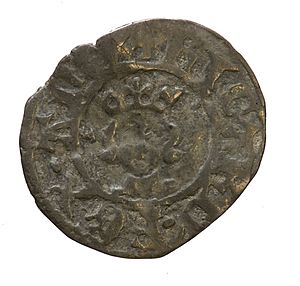
Richard slowly regained his royal power in the months after the Merciless Parliament. The Lords Appellant's aggressive foreign policy failed. Their attempts to create a large anti-French alliance came to nothing. Also, northern England suffered from a Scottish attack. Richard was now over 21 years old and could confidently claim the right to rule on his own. Furthermore, John of Gaunt returned to England in 1389 and made peace with the king. After this, Gaunt acted as a calming influence on English politics. Richard took full control of the government on May 3, 1389. He said that the problems of the past years were only due to bad advisors. He announced a foreign policy that reversed the Appellants' actions. He sought peace with France and promised to greatly reduce taxes for the people. Richard ruled peacefully for the next eight years, having made up with his former enemies. Still, later events would show that he had not forgotten the insults he felt, especially the execution of his former teacher, Sir Simon de Burley.

With stability in the country, Richard began to negotiate a lasting peace with France. A plan in 1393 would have greatly expanded the English territory of Aquitaine. However, the plan failed because it required the English king to pay homage (show respect and loyalty) to the King of France. This was unacceptable to the English public. Instead, in 1396, a truce (temporary peace) was agreed upon, which would last 28 years. As part of the truce, Richard agreed to marry Isabella of Valois, daughter of Charles VI of France, when she was old enough. There were some concerns about this marriage, especially because the princess was only six years old. This meant she would not be able to have an heir to the English throne for many years.
Although Richard wanted peace with France, he took a different approach to the situation in Ireland. The English lands in Ireland were in danger of being taken over by the Gaelic Irish kingdoms. The Anglo-Irish lords asked the king to help. In the autumn of 1394, Richard went to Ireland, where he stayed until May 1395. His army of more than 8,000 men was the largest force brought to the island in the late Middle Ages. The invasion was a success, and several Irish chieftains submitted to English rule. This was one of the most successful achievements of Richard's reign. It strengthened his support at home, though the English position in Ireland did not last long.
The Second Crisis: 1397–1399
Historians call the period towards the end of the 1390s Richard II's "tyranny." The king had Gloucester, Arundel, and Warwick arrested in July 1397. The exact timing and Richard's reasons are not entirely clear. One historical account suggested a plot against the king, but there is no strong evidence for this. It is more likely that Richard simply felt strong enough to safely get revenge on these three men for their roles in the events of 1386–1388. He wanted to remove them as threats to his power.
Arundel was the first of the three to be put on trial at the Parliament in September 1397. After a heated argument with the king, he was found guilty and executed. Gloucester was held prisoner by the Earl of Nottingham in Calais while waiting for his trial. As the trial time neared, Nottingham brought news that Gloucester was dead. It is believed that the king ordered him to be killed to avoid the shame of executing a royal family member.
Warwick was also sentenced to death, but his life was spared, and his sentence was changed to life imprisonment. Arundel's brother, Thomas Arundel, the Archbishop of Canterbury, was sent into exile for life. Richard then continued to punish his opponents in different areas. While gathering his own loyal followers in various counties, he prosecuted local men who had been loyal to the Appellants. The fines collected from these men brought a lot of money to the crown. However, writers at the time questioned if these actions were legal.
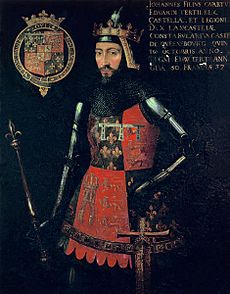
These actions were mainly possible because John of Gaunt cooperated. Richard also had the support of many other powerful nobles. Many of them were rewarded with new titles and were sometimes called Richard's "duketti" (little dukes). These included former Lords Appellant:
- Henry Bolingbroke, Earl of Derby, who was made Duke of Hereford.
- Thomas de Mowbray, Earl of Nottingham, who was made Duke of Norfolk.
Also among them were:
- John, the king's half-brother, promoted from Earl of Huntingdon to Duke of Exeter.
- Thomas Holland, the king's nephew, promoted from Earl of Kent to Duke of Surrey.
- Edward of Norwich, Earl of Rutland, the king's cousin, who received Gloucester's French title of Duke of Aumale.
- Gaunt's son John Beaufort, 1st Earl of Somerset, who was made Marquess of Somerset and Marquess of Dorset.
- John Montacute, 3rd Earl of Salisbury.
- Lord Thomas le Despenser, who became Earl of Gloucester.
With the lands taken from the convicted Appellants, the king could reward these men with lands that matched their new high ranks.
However, a threat to Richard's power still existed in the form of the House of Lancaster. This family was represented by John of Gaunt and his son, Henry Bolingbroke, Duke of Hereford. The House of Lancaster not only had more wealth than any other family in England, but they were also of royal blood. Because of this, they were likely candidates to become king after the childless Richard.
A disagreement broke out among the king's inner circle in December 1397. Bolingbroke and Mowbray got into an argument. According to Bolingbroke, Mowbray had claimed that they, as former Lords Appellant, were next in line for the king's punishment. Mowbray strongly denied these charges, as such a claim would have been treason. A parliamentary committee decided that the two should settle the matter by battle. But at the last moment, Richard sent both dukes into exile instead: Mowbray for life, Bolingbroke for ten years.
In 1398, Richard called the Parliament of Shrewsbury. This Parliament declared all the acts of the Merciless Parliament to be invalid. It also announced that no limits could legally be placed on the king. It gave all parliamentary power to a committee of twelve lords and six commoners chosen from the king's friends. This made Richard an absolute ruler, meaning he didn't need to call Parliament again.
On February 3, 1399, John of Gaunt died. Instead of allowing Bolingbroke to inherit his father's lands, Richard extended his exile to life and took all his properties. The king felt safe from Bolingbroke, who was living in Paris. This was because the French had little interest in challenging Richard and his peace policy. Richard left England in May for another military trip to Ireland.
Royal Court and Culture

In the last years of Richard's reign, especially after he dealt with the Appellants in 1397, the king had almost complete power in England. This was unusual for medieval England. During this time, a special court culture developed that was very different from earlier times. A new way of addressing the king appeared. Before, the king was simply called "highness." Now, "royal majesty" or "high majesty" were often used. It was said that on important holidays, Richard would sit on his throne in the royal hall for hours without speaking. Anyone he looked at had to bow down to him. This new lavishness and focus on dignity came from courts in Europe, like those in France and Bohemia (where Richard's wives came from). It also came from the court his father had kept while living in Aquitaine.
Richard's way of ruling came from his strong belief in the king's special powers. This belief started in his early youth when his authority was challenged by the Peasants' Revolt and then by the Lords Appellant. Richard did not like the way his grandfather, Edward III, had dealt with the nobility. Edward's court was very military, based on the king and his trusted nobles working together as military leaders. Richard felt this gave too much power to the nobles. To avoid depending on the nobility for soldiers, he sought peace with France. At the same time, he built his own private army, larger than any English king before him. He gave them livery badges with his White Hart symbol. He was then free to create a court where the king was a distant, respected figure, and art and culture, rather than war, were most important.
Art and Royal Support
Richard also tried to improve his royal image. Unlike any other English king before him, he had himself painted in grand portraits. Two of these still exist: a large Westminster Abbey portrait (around 1390) and the Wilton Diptych (1394–1399). The Diptych was a portable painting likely meant to go with Richard on his Irish trip. It is one of the few surviving English examples of the fancy International Gothic painting style. This style was popular in European courts, especially in Prague and Paris. Richard spent much more money on jewelry, rich fabrics, and metalwork than on paintings. But like his illuminated manuscripts, there are hardly any surviving works directly linked to him, except for a crown. This crown, "one of the finest achievements of the Gothic goldsmith," probably belonged to his wife Anne.
One of Richard's biggest building projects was Westminster Hall. It was greatly rebuilt during his reign, perhaps encouraged by the completion of John of Gaunt's grand hall at Kenilworth Castle in 1391. Fifteen life-size statues of kings were placed in niches on the walls. The hammer-beam roof, built by the royal carpenter Hugh Herland, was called "the greatest creation of medieval timber architecture." It allowed the original three Romanesque aisles to be replaced with one huge open space. At one end was a raised platform where Richard could sit alone in majesty. The rebuilding had been started by Henry III in 1245 but had stopped for over a century by Richard's time.
The court's support for literature is especially important. This was the time when the English language became a literary language. There isn't much direct proof that Richard supported poetry. However, this culture was able to grow within his court. The greatest poet of that time, Geoffrey Chaucer, worked for the king as a diplomat, customs official, and clerk. He wrote some of his most famous works during this time. Chaucer also worked for John of Gaunt and wrote The Book of the Duchess to honor Gaunt's wife, Blanche. Chaucer's friend John Gower wrote his Confessio Amantis directly for Richard, though he later became unhappy with the king.
Richard's Downfall
Losing the Crown
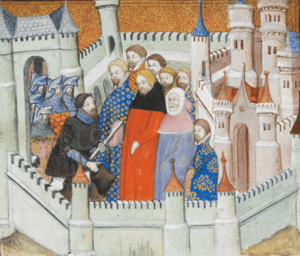
In June 1399, Louis I, Duke of Orléans, gained control of the court of the mentally ill Charles VI of France. Louis did not like the policy of friendship with the English crown. So, he found it useful to allow Henry Bolingbroke to leave for England. With a small group of followers, Bolingbroke landed at Ravenspurn in Yorkshire in late June 1399. People from all over the country quickly joined him. Meeting with Henry Percy, 1st Earl of Northumberland, who also had concerns about the king, Bolingbroke insisted that he only wanted to get back his own family lands. Percy believed him and did not interfere. The king had taken most of his loyal knights and nobles with him to Ireland. So, Bolingbroke met little resistance as he moved south. The Keeper of the Realm, Edmund, Duke of York, had no choice but to side with Bolingbroke.
Meanwhile, Richard was delayed in returning from Ireland. He did not land in Wales until July 24. He made his way to Conwy, where on August 12, he met with the Earl of Northumberland for talks. On August 19, Richard surrendered to Henry Bolingbroke at Flint Castle. He promised to give up his throne if his life was spared. Both men then returned to London, with the unhappy king riding behind Henry. Upon arrival, he was imprisoned in the Tower of London on September 1.
Henry was now determined to take the throne. But finding a good reason for this action was a challenge. It was argued that Richard, through his harsh and bad rule, had shown himself unworthy of being king. However, Henry was not the next in line to the throne. The likely heir was Edmund Mortimer, 5th Earl of March, who was the great-grandson of Edward III's second surviving son, Lionel, Duke of Clarence. Bolingbroke's father, John of Gaunt, was Edward's third son to survive to adulthood. The problem was solved by emphasizing Henry's direct male family line. March's claim came through his grandmother, Philippa of Clarence.
According to the official record, read by the Archbishop of Canterbury during a meeting of lords and commoners at Westminster Hall on September 30, Richard willingly gave up his crown. He said he was unworthy as a monarch. On the other hand, the Traison et Mort Chronicle tells a different story. It describes a meeting between Richard and Henry one day before Parliament's session. The king became very angry, demanded to be released from the Tower, called his cousin a traitor, asked to see his wife, and swore revenge. He threw down his hat, while Henry refused to do anything without Parliament's approval. When Parliament met to discuss Richard's fate, John Trevor, Bishop of St Asaph, read 33 reasons for Richard's removal. These were accepted by everyone. On October 1, 1399, Richard II was formally removed from power. On October 13, Henry Bolingbroke was crowned king.
The King's Death
Henry had agreed to let Richard live after he gave up the throne. This changed when it was discovered that several nobles were planning to kill the new king and bring Richard back. These nobles included the earls of Huntingdon, Kent, and Salisbury, Lord Despenser, and possibly the Earl of Rutland. All of them had been given high ranks by Richard but were now demoted. This plot, known as the Epiphany Rising, was stopped. But it showed how dangerous it was to let Richard live. He is believed to have died from starvation while imprisoned in Pontefract Castle around February 14, 1400. However, there are some questions about the exact date and how he died. His body was taken south from Pontefract and shown in St Paul's Cathedral on February 17. He was then buried in King's Langley Priory on March 6.
Rumors that Richard was still alive continued, but they were not widely believed in England. In Scotland, however, a man claiming to be Richard came into the hands of Regent Albany. This man was kept in Stirling Castle and used as a figurehead for various plots against Henry IV. Henry IV's government said he was an impostor. Several sources from both sides of the border suggest the man had a mental illness. One source described him as a "beggar" by the time of his death in 1419. But he was buried as a king in the local Dominican friary in Stirling. Meanwhile, in 1413, Henry V decided to move Richard's body from King's Langley to its final resting place in Westminster Abbey. Henry V did this to make up for his father's actions and to stop the rumors of Richard's survival. Richard himself had prepared an elaborate tomb there, where his wife Anne was already buried.
Richard's Personality and Legacy
Contemporary writers, even those who didn't like the king, agreed that Richard was a "most beautiful king." They described him as having a "face which was white, rounded and feminine," which some thought meant he lacked manliness. He was athletic and tall. When his tomb was opened in 1871, he was found to be six feet (1.82 m) tall. He was also intelligent and well-read. When he was upset, he tended to stammer. The Westminster Abbey portrait probably shows a good likeness of the king. However, the Wilton Diptych shows him much younger than he was at the time. He likely had a beard by then. In terms of religion, he was traditional. Especially towards the end of his reign, he strongly opposed the Lollard heresy. He was particularly devoted to the worship of Edward the Confessor. Around 1395, he combined his own coat of arms with the mythical arms of the Confessor. Although not a warrior king like his grandfather, Richard still enjoyed tournaments and hunting.
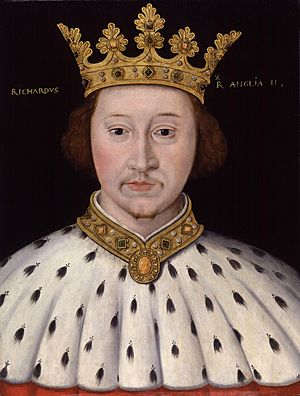
The popular view of Richard has been most influenced by William Shakespeare's play about the king, Richard II. Shakespeare's Richard was shown as a cruel, vengeful, and irresponsible king. He only seemed great after he lost power. Shakespeare took many liberties and left out many details. He based his play on works by writers like Edward Hall and Samuel Daniel, who in turn used accounts from writers like Thomas Walsingham. Hall and Daniel were part of a historical view from the Tudor period, which was very negative towards Richard. This Tudor view, strengthened by Shakespeare, saw a continuous period of civil unrest starting with Richard's bad rule. This unrest supposedly did not end until Henry VII became king in 1485. The idea that Richard was to blame for the later 15th-century Wars of the Roses was common until the 19th century. But it began to be questioned in the 20th century. Some recent historians prefer to view the Wars of the Roses separately from Richard II's reign.
Richard's mental state has been a big topic of historical debate since the first academic historians studied him in the 19th century. One of the first modern historians to study Richard II as a king and a person was Bishop Stubbs. Stubbs argued that towards the end of his reign, Richard's mind "was losing its balance altogether." Historian Anthony Steel, who wrote a full biography of the king in 1941, used a psychiatric approach. He concluded that Richard had schizophrenia. This was challenged by V. H. Galbraith, who argued there was no historical basis for such a diagnosis. Later historians, like Anthony Goodman and Anthony Tuck, have followed this line. Nigel Saul, who wrote the most recent academic biography on Richard II, agrees that there is no basis for assuming the king had a mental illness. However, he showed clear signs of a narcissistic personality. Towards the end of his reign, "Richard's grasp on reality was becoming weaker."
One of the main historical questions about Richard is about his political goals and why they failed. His kingship was thought to have elements of the early modern absolute monarchy, like that of the Tudor dynasty. More recently, some historians have seen Richard's idea of kingship as not so different from his ancestors. They argue that by staying within the traditional monarchy, he was able to achieve a lot. Yet, his actions were too extreme and too sudden. For example, the absence of war was meant to reduce taxes and make Richard popular with Parliament. However, this promise was never kept. The cost of his royal followers, the luxury of his court, and Richard's generous gifts to his favorites were as expensive as war had been. But they didn't offer the same benefits. As for his policy of keeping a private army, this was later copied by Edward IV and Henry VII. But Richard II's reliance only on the county of Cheshire hurt his support from the rest of the country. Simon Walker writes: "What he sought was, in contemporary terms, neither unjustified nor unattainable; it was the manner of his seeking that betrayed him."
Family Tree
| Family of Richard II of England | |||||||||||||||||||||||||||||||||||||||||||||||||||||||||||||||||||||||||||||||||||||||||||||||||||||||||||||||||||||||||||||||||||||||||||||||||||||||||||||||||||||||||||||||||||||||||||||||||||||||||||||||||||||||||||||||||||||||||||||||||||||||||||||||||||||||||||||||||||||||||||||||||||||||||||||||||||||||||||||||||||||||||||||||||||||||||||||||||||||||||||||||||||||||||||||||||||||||||||||||||||||||||||||||||||||||||||||||||||||||||||||||||
|---|---|---|---|---|---|---|---|---|---|---|---|---|---|---|---|---|---|---|---|---|---|---|---|---|---|---|---|---|---|---|---|---|---|---|---|---|---|---|---|---|---|---|---|---|---|---|---|---|---|---|---|---|---|---|---|---|---|---|---|---|---|---|---|---|---|---|---|---|---|---|---|---|---|---|---|---|---|---|---|---|---|---|---|---|---|---|---|---|---|---|---|---|---|---|---|---|---|---|---|---|---|---|---|---|---|---|---|---|---|---|---|---|---|---|---|---|---|---|---|---|---|---|---|---|---|---|---|---|---|---|---|---|---|---|---|---|---|---|---|---|---|---|---|---|---|---|---|---|---|---|---|---|---|---|---|---|---|---|---|---|---|---|---|---|---|---|---|---|---|---|---|---|---|---|---|---|---|---|---|---|---|---|---|---|---|---|---|---|---|---|---|---|---|---|---|---|---|---|---|---|---|---|---|---|---|---|---|---|---|---|---|---|---|---|---|---|---|---|---|---|---|---|---|---|---|---|---|---|---|---|---|---|---|---|---|---|---|---|---|---|---|---|---|---|---|---|---|---|---|---|---|---|---|---|---|---|---|---|---|---|---|---|---|---|---|---|---|---|---|---|---|---|---|---|---|---|---|---|---|---|---|---|---|---|---|---|---|---|---|---|---|---|---|---|---|---|---|---|---|---|---|---|---|---|---|---|---|---|---|---|---|---|---|---|---|---|---|---|---|---|---|---|---|---|---|---|---|---|---|---|---|---|---|---|---|---|---|---|---|---|---|---|---|---|---|---|---|---|---|---|---|---|---|---|---|---|---|---|---|---|---|---|---|---|---|---|---|---|---|---|---|---|---|---|---|---|---|---|---|---|---|---|---|---|---|---|---|---|---|---|---|---|---|---|---|---|---|---|---|---|---|---|---|---|---|---|---|---|---|---|---|---|---|---|---|---|---|---|---|---|---|---|---|---|---|---|---|---|---|---|---|---|---|---|---|---|---|---|---|---|---|---|---|---|---|---|---|---|---|
|
|||||||||||||||||||||||||||||||||||||||||||||||||||||||||||||||||||||||||||||||||||||||||||||||||||||||||||||||||||||||||||||||||||||||||||||||||||||||||||||||||||||||||||||||||||||||||||||||||||||||||||||||||||||||||||||||||||||||||||||||||||||||||||||||||||||||||||||||||||||||||||||||||||||||||||||||||||||||||||||||||||||||||||||||||||||||||||||||||||||||||||||||||||||||||||||||||||||||||||||||||||||||||||||||||||||||||||||||||||||||||||||||||
Images for kids
See Also
 In Spanish: Ricardo II de Inglaterra para niños
In Spanish: Ricardo II de Inglaterra para niños


